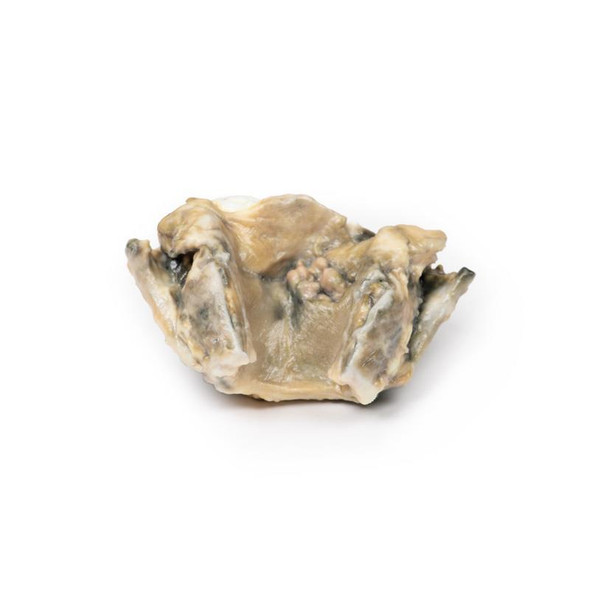Description
Clinical History
A 76-year old female presented to the emergency department sudden loss of consciousness. She had signs of a left sided cerebrovascular accident. She was intubated and her stroke was treated. During her admission in ICU she was noted to have a fixed mass in her left breast with palpable lymphadenopathy in her left axilla. She died from a respirator associated pneumonia.
Pathology
The specimen is the patient's left breast mounted to display the cut surface. Immediately beneath and attached to the skin is a large oval tumor mass 11cm in maximum diameter. The tumor is adherent to the underlying muscle. The tumor is not encapsulated and has a variegated cut surface with areas of necrosis, hemorrhage and cyst formation. This is a breast adenocarcinoma, which involved the regional lymph nodes.
Further Information
Breast carcinoma is the second most commonly diagnosed cancer in women worldwide. It is rare in women under 30 years of age but the incidence increases significantly after 30 with the peak occurring at 70 to 80 years. Incidence has been decreasing since the introduction of breast cancer screening programs, which offer mammography to women at risk and public awareness and education in self-examination of the breast. However, breast cancer remains one of the leading causes of cancer-related death in women.
Major risk factors for developing breast carcinoma include being of female gender (men account for 1% of breast cancer diagnosis), exposure to estrogen (early menarche, late menopause, exogenous estrogen), family history of breast cancer, being nulliparous, not breastfeeding, radiation exposure and obesity. Germline mutations in tumor suppressor genes, such as BRCA1, BRCA2, TP53, ATM, CDH1 and CHEK2 are linked with some hereditary cases of breast cancer.
Most breast neoplasms are adenocarcinomas that begin in the duct/lobular system as carcinoma in situ (DCIS). These malignancies are further subdivided according to their expression of estrogen receptors (ER) and Human epidermal growth factor 2 (HER2), which guides treatment. The most frequent sites if distant metastasis occur are bone, liver, lung and brain.
In developed countries with screening programs most patients present following an abnormal mammogram. Symptomatic patients present with a breast mass which is classically hard, irregular, immovable. Other clinical symptoms are axillary lymphadenopathy, overlying skin changes (erythematous or thickened skin, dimpled skin (peau d'orange) and nipple retraction. Symptoms of distant spread of disease may also cause patient presentations.
Treatment depends on the stage of the disease and the ER and HER2 status of the tumor. Surgical treatments include uni or bilateral mastectomy or breast conserving lumpectomy. Surgical axillary node clearance is performed in cases with positive nodal disease. Radiotherapy is given to patients with high risk of local recurrence. Patients with HER2 positive cancers are treated with targeted drugs, such as trastuzumab (Herceptin). Patients with ER positive tumors can be treated using anti-estrogen therapy, such as tamoxifen. Systemic chemotherapy is also used to treat some patients with breast cancer.
Advantages
- Anatomically accurate and identical to real specimen
- No ethical issues - not real human body parts
- Reasonably priced
- Available within a short lead time
- Reproducible, several identical prints can be used as a classroom set
- Can be produced in different sizes to cater for the needs of the teacher
Human Cadavers
- Access to cadavers can be problematic. Many countries cannot access cadavers for cultural and religious reasons
- Cadavers cost a lot money
- High cost for establishing your own plastination suite
- Wet specimens cannot be used in uncertified labs
- Dissection of cadavers is a lot of staff time and that is a cost
- Storage of cadaver material needs special refrigeration etc. which has coast
- If you want another specimen you have to start all over again
Plastinates
- Costs
- Ethical issues
- Timeframe for plastination process
- Many countries do not allow their importation
- One of a kind
Superior 3D print results compared with conventional methods
- Vibrant color offering with 10 million colors
- UV-curable inkjet printing
- High quality 3D printing that can create products that are delicate, extremely precise and incredibly realistic
Clear Support Material
- To avoid breakage of fragile, thin, and delicate arteries, veins or vessels, a clear support material is printed on such spots. This makes the models robust and can be handled by students easily.

















